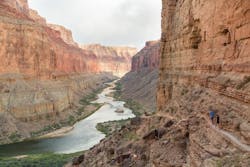Groundwater Levels Declining in Colorado River
A restoration site in Colorado River Delta is one of three south of the U.S.- Mexico border along the last miles of the Colorado River. There, a small amount of water has been reserved for nature, returned to an river whose flow has been claimed by cities and farms.
One source that is increasingly important for restoring these areas in the delta's riparian corridor is groundwater.
According to AZ Central, scientists who monitor restoration in the delta wrote in a report that a shallow water table, one with higher groundwater levels, is essential to the survival of riparian vegetation in the broad expanses of the delta.
“The trees, the cottonwoods and willows, they need to be connected to the groundwater directly,” said Osvel Hinojosa-Huerta, a scientist at the Cornell Lab of Ornithology. “They have shallow roots so the groundwater level is very important to their survival.”
Now, groundwater levels have declined, much like the river’s surface flows that once flowed into the Gulf of California. According to AZ Central, some of the declines may be due to drought, some to over pumping and some to the loss of agricultural runoff as farmers become more efficient.
Eloise Kendy, a scientist at the Nature Conservancy who worked on the 2018 study, said so much water poured into the aquifer that it overflowed, creating a vast wetland.
Researchers warn that a groundwater “depletion zone,” where levels have dropped too far to support riparian vegetation, is extending both upriver and downriver from an area near the border. According to AZ Central, such zones are created when the groundwater pumped out exceeds what is replaced.
“If [groundwater levels] continue to go down there’s not going to be enough water to fulfill the restoration objectives,” Hinojosa-Huerta said.
According to a 2017 report that assessed the vulnerability and sustainability of the region under different scenarios, although restoration efforts in the delta have shown progress, habitat within the riparian corridor is more vulnerable to declining groundwater levels.
When groundwater levels are deeper, trees like cottonwoods need more time to sink their roots into the water table, which means they’ll need to be irrigated for longer, Hinojosa-Huerta said. In some cases, they’ll have to be irrigated forever.
